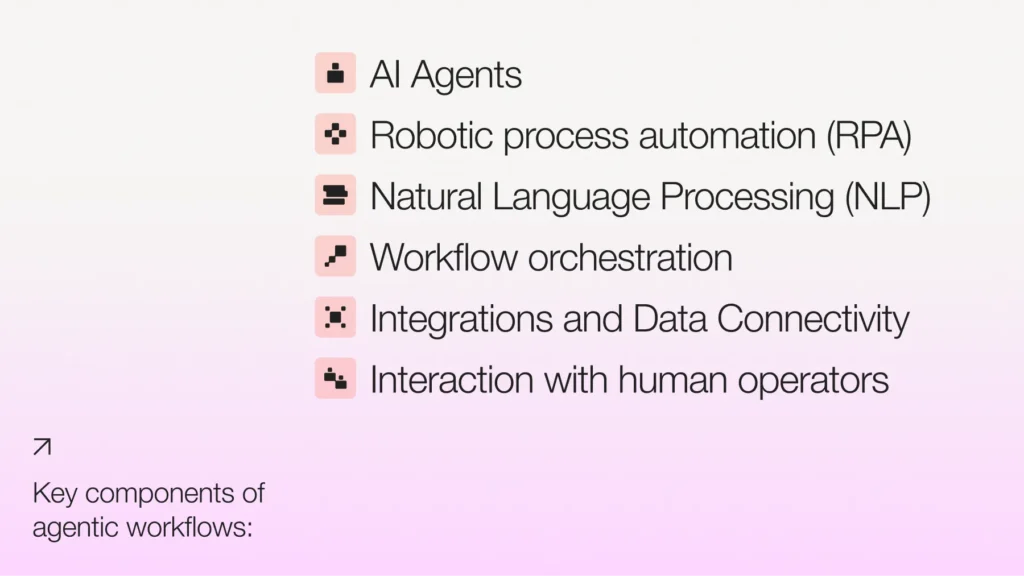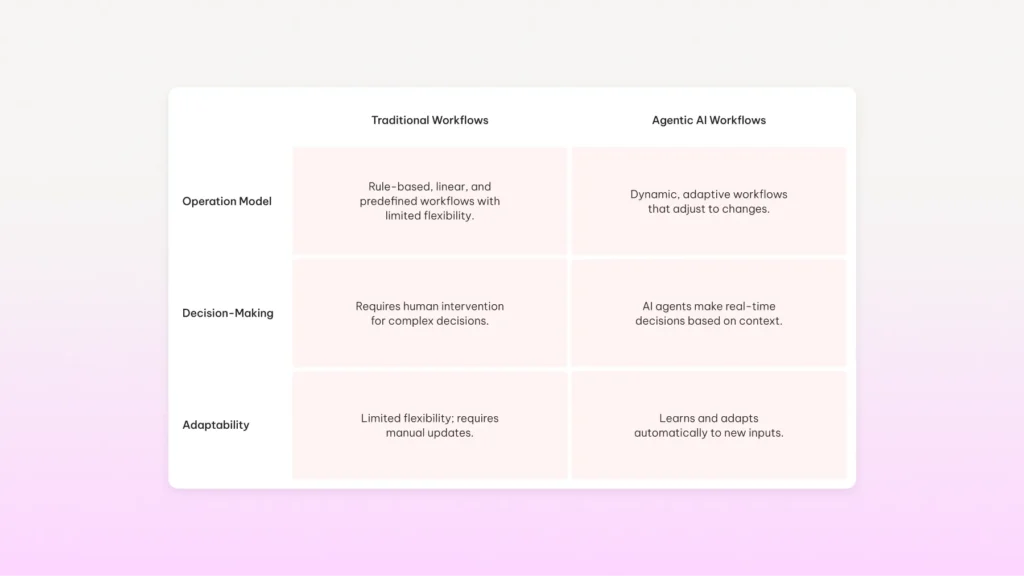Table of Contents

What are Agentic Workflows? Components, Benefits & Use Cases
Agentic workflows are AI-driven processes in which specialized intelligent agents make independent decisions, adapt to new information, and dynamically execute tasks.
Unlike traditional workflows, which follow fixed rules and require human oversight, agentic workflows enable AI to adjust actions in real-time, making them ideal for more complex enterprise scenarios. AI workflows are gaining traction, and research suggests that 50% of businesses will use agentic AI pilots by 2027.
In this article, we explore the fundamental nature of agentic workflows, their essential components, key benefits, and compelling real-world applications that are already reshaping enterprise operations.
What are agentic workflows?
Agentic workflows are AI-driven sequences of tasks that can execute dynamically with reduced human intervention.
Unlike traditional workflows, which often require humans to gather information, verify details, or resolve issues, agentic workflows leverage AI agents to perceive their environment, make decisions within defined parameters, and take appropriate actions.
For example, in supply chain management, a multi-agent workflow can:
- Open a new case and retrieve order details
- Identify potential replacement products based on specifications and availability
- Check warehouse inventory in real time
- Recommend or, within specified boundaries, initiate replacement orders
This AI-driven approach reduces order fulfillment delays, improves supply chain resilience, and optimizes operational efficiency at scale, while still allowing for human oversight of critical decisions when necessary.
How do agentic workflows work?
Unlike rule-based automation that follows fixed sequences, agentic workflows continuously assess situations, adjust processes, and take actions based on evolving conditions within their defined parameters. To accomplish this, agentic workflows require the ability to understand context, interpret information, and interact with systems and users through well-defined interfaces.
In an agentic workflow, data is collected and processed by machine learning algorithms to identify patterns and inform decisions, which are then executed with contextual awareness. AI agents can navigate through various stages to reach a goal, including data collection and preprocessing, pattern recognition, decision-making based on established criteria, and executing appropriate actions.
The specific actions an agent takes depend on its designed capabilities and may include updating systems, sending notifications, triggering complementary workflows, or performing specialized tasks such as scheduling appointments, identifying risks, or highlighting opportunities—all within boundaries established during system design.
Key components of agentic workflows
Agentic AI workflows need several key components to execute tasks dynamically, adapt to changing conditions, and optimize decision-making.
AI Agents
These are specialized software programs that observe data inputs, make decisions based on their programming, and take actions to complete specific tasks within a workflow. Multiple agents often work together in a system, each handling different parts of a process while sharing information and coordinating with one another.
Robotic process automation (RPA)
RPA handles repetitive, rule-based tasks such as data entry and order processing. When integrated with AI capabilities, these automated processes can become more adaptive to varying inputs and conditions.
Natural Language Processing (NLP)
Natural Language Processing (NLP) helps AI agents to understand and generate human language.
NLP enables AI systems to interpret and generate human language, facilitating more natural interactions between humans and machines.
Workflow orchestration
Orchestration systems coordinate the activities of various AI components, RPA processes, and human operators, ensuring they work together effectively in a structured process.
Integrations and Data Connectivity
Connectivity features allow agentic workflows to interact with enterprise applications, APIs, and databases, enabling them to access and update information across systems.
Interaction with human operators
Effective agentic workflows typically incorporate human oversight, allowing people to guide, review, and intervene in AI processes when necessary, particularly for complex or sensitive decisions.

Agentic workflows vs. Traditional workflows
Traditional workflows operate on fixed rules, requiring human intervention for tasks such as data gathering, verification, and issue resolution, while agentic workflows allow AI agents to autonomously adjust actions, optimize processes, and handle real-time changes without waiting for human input.
This limits their ability to adapt to dynamic environments. In contrast, agentic workflows allow AI agents to autonomously adjust actions, optimize processes, and handle real-time changes without waiting for human input, making them ideal for enterprises managing high-volume, complex operations.
Here’s a table to show the difference.
| Traditional Workflows | Agentic AI Workflows | |
| Operation Model | Predefined, rule-based tasks executed in a linear sequence with fixed pathways and limited branches | Dynamic sequences of functions executed by AI agents, adaptive and responsive to changing circumstances |
| Decision-Making | Limited to explicitly programmed scenarios. Requires human workers to make decisions based on nuances and exceptions | AI agents make decisions within defined parameters and adapt their processes in real-time based on contextual understanding |
| Adaptability | Limited ability to adapt to new variables; requires manual updates to handle unexpected conditions | Adapts to new inputs and changing circumstances in real-time, learning from experiences to improve performance within the bounds of its design |
Agentic workflows deliver unparalleled flexibility and efficiency, allowing businesses to automate complex decision-making, reduce human workload, and scale operations seamlessly.
Benefits of agentic workflows for enterprise
By implementing agentic workflows, enterprises can improve efficiency, reduce costs, and enhance automation capabilities, ensuring they stay competitive in an increasingly AI-driven world.
Improved scalability
Agentic workflows allow businesses to scale operations efficiently without needing to increase staffing proportionally. Automating repetitive processes enables enterprises to handle larger workloads with the same or fewer resources, improving efficiency without sacrificing quality.
For example, an AI-powered campaign management workflow in marketing can automate email scheduling, customer segmentation, and performance tracking, freeing human teams to focus on creative strategy and content development.
Enhanced customer service
AI agents improve customer service by managing routine inquiries, assisting support agents, and delivering personalized recommendations. This leads to faster response times and higher service quality.
For example, in e-commerce, an AI-powered customer service system can handle FAQs through chatbots, reduce wait times, assist live agents by retrieving order details instantly, and recommend relevant products based on browsing history.
Improved productivity
By automating complex decision-making with agentic AI workflows, enterprises can significantly streamline operations.
A McKinsey study estimated that AI-driven automation could contribute over $400B in productivity gains across industries such as supply chain optimization, customer service, and financial reporting.

Agentic AI workflow use cases
Many potential use cases exist for Agentic AI, and workflows can be complex for high-risk sectors, including trading and healthcare.
Healthcare
AI agents can manage and coordinate healthcare services, such as appointment scheduling and patient care tasks. This includes monitoring vital signs, administering medication, and providing personalized care.
For example, when a doctor submits a prior authorization request, an AI intake agent gathers patient data from medical records and insurance details. A validation agent checks if the request meets medical and insurance guidelines and recommends approval or further review. If approved, a communication agent updates the system and notifies the doctor and patient, automatically triggering the next steps for treatment.
Customer Service
Agentic AI workflows enable autonomous, context-aware interactions, offering improved response times, accuracy, and overall customer satisfaction. Unlike traditional chatbots that follow scripted responses, AI-driven agentic workflows dynamically adapt to customer needs, ensuring more seamless and personalized support experiences.
For example, when a customer submits a request, an AI classification agent sorts the inquiry and retrieves customer history. If it’s a simple issue like a refund or order update, a resolution agent processes it instantly and sends a confirmation. For complex cases, an escalation agent compiles key details and forwards them to a human agent with suggested solutions for a faster resolution.
Finance
Agentic AI can automate complex document analysis, risk assessments, and compliance monitoring, reducing manual effort and improving decision accuracy with reduced risks.
For example, when a bank receives a contract, an AI agent scans and extracts key details. A risk assessment agent checks for financial risks, while a compliance agent ensures it meets current regulations. A decision agent finalizes the contract and triggers the following workflow if approved. If issues are found, it automatically flags them for human review, streamlining the approval process while safeguarding the business.
Considerations before AI workflow implementation
Implementing AI agentic workflows requires the proper technical infrastructure requirements, skilled developers, and time to overcome ethical and practical considerations.
Biases
AI agents can perpetuate and even amplify biases present in their training data, leading to unintended discriminatory outcomes in decision-making processes. In high-risk applications, AI-driven recommendations should undergo human review during the workflow.
Security
AI agents must protect sensitive user data and comply with data privacy regulations like GDPR. To prevent data breaches, security mechanisms such as encryption, access controls, and authentication can be implemented. Ensure that the AI systems can pull the data they need without exposing it, and consider ring-fencing some sensitive content.
Data quality
Poor data quality, data silos, and privacy violations can undermine the reliability and trustworthiness of AI agentic workflows. As such, it’s crucial to ensure data accessibility while adhering to only what’s needed to get the work done.
Embracing agentic AI workflows: The future of enterprise automation
Agentic AI workflows are fundamentally transforming enterprise automation across industries by enabling real-time decision-making, adaptive processes, and seamless collaboration between AI agents and human operators.
These intelligent systems represent a significant competitive advantage for enterprise organizations facing increasing complexity, data volumes, and customer expectations.
Unlike traditional rule-based systems that struggle with exceptions and changing conditions, agentic workflows analyze data holistically, adapt to evolving circumstances, and execute tasks with greater autonomy. This makes them particularly valuable for enterprise-scale operations where efficiency, consistency, and responsiveness directly impact bottom-line results.
As organizations continue their digital transformations, those that strategically adopt agentic workflows may position themselves to scale operations more effectively, respond more rapidly to market changes, and deliver increasingly personalized experiences to both customers and employees.


